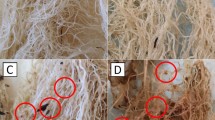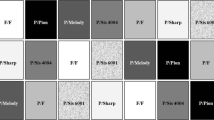Abstract
Plant-parasitic nematodes are serious pests causing important crop losses worldwide. After extensive screening of non-tuber-bearing Solanaceae, a resistant trap crop, Solanum sisymbriifolium, with a high production level of hatching agents, seemed an ideal control method for potato cyst nematodes (PCN), Globodera spp. Recently, root-knot nematodes (RKN), Meloidogyne spp., were found coexisting with PCN. Therefore, it is important to find alternative methods to control both nematode genera. The chemical properties of S. sisymbriifolium turns this plant into an excellent candidate for further nematicidal studies and to develop new crop production models. Studies concerning the effects of this plant on plant-parasitic nematodes are presented. Pathogenicity studies with four S. sisymbriifolium cvs (Domino, Pion, Sis 4004 and Sharp) and five Meloidogyne species showed that all cultivars of S. sisymbriifolium studied were resistant to M. chitwoodi and hypersusceptible to M. arenaria and M. hapla. For M. hispanica only cv Pion was susceptible. M. javanica induced different responses: cvs Pion and Sharp were susceptible; cv Domino resistant and Sis 4004 hypersusceptible. The studies of the hatching effects of root exudates from these cvs showed that they had an influence on the hatching inhibition of second stage juveniles of the five Meloidogyne species tested.

Similar content being viewed by others
References
Abbott, W. S. (1925). A method of computing the effectiveness of an insecticide. Journal of Economic Entomology, 18, 265–266.
Abrantes, I., Santos, S. de A., Bourne, J., Ciancio, A., Lopez-Llorca, L., Kerry, B., Mota, M., Tzortzakakis, E., & Verdejo-Lucas, S. (2002). A manual for research on Verticillium chlamydosporium, a potential biological control agent for root-knot nematodes. In B. R. Kerry & J. M. Bourne J. M (Eds.), International Organization for Biological and Integrated Control of Noxious Animals and Plants/West Palearctic Regional Section (IOBC/WPRS). Gent, Belgium, 84 pp.
Byrd, D. W., Kirkpatrick, T., & Bakker, K. R. (1983). An improved technique for clearing and staining tissues for detection of nematodes. Journal of Nematology, 15, 142–143.
Canto-Sáenz, M. (1985). The nature of resistance to Meloidogyne incognita (Kofoid & White, 1919) Chitwood, 1949. In J. N. Sasser & C. C. Carter (Eds.), An advanced treatise on Meloidogyne; biology and control (pp. 225–231). Raleigh: North Carolina State University Graphics.
Chitwood, D. J. (2002). Phytochemical based strategies for nematode control. Annual Review of Phytopathology, 40, 221–249.
Clarke, A. J., & Shepherd, A. M. (1966). Inorganic ions and the hatching of Heterodera spp. Annals of Applied Biology, 58, 497–508.
Conceição, I. L. P. M. da, da Cunha, M. J. M., Feio, G., Correia, M., dos Santos, M. C. V., de Abrantes, I. M. O., & de Santos, M. S. N. A. (2009). Root-knot nematodes, Meloidogyne spp., on potato in Portugal. Nematology, 11, 311–313.
Directive 2007/33/CE of the Council, of 11 June 2007, relative to the control of the nematodes of the cyst of the potato and by which derogates the Directive 69/465/CEE. TWELVE L 156, 16-6-2007.
Evans, K., & Kerry, B. (2007). Changing priorities in the management of potato cyst nematodes. Outlooks on Pest Management, 265–269.
Fassuliotis, G. (1979). Plant breeding for root-knot nematode resistance. In F. Lamberti & C. E. Taylor (Eds.), Root-knot nematodes (Meloidogyne species) systematic, biology and control (pp. 425–453). London, New York: Academic Press Inc.
Global Invasive Species Database. Retrieved May 13, 2011 from http://www.issg.org/database.
Halford, P. D., Russell, M. D., & Evans, K. (1999). Use of resistant and susceptible potato cultivars in the trap cropping of potato cyst nematodes, Globodera pallida and G. rostochiensis. Annals of Applied Biology, 134, 321–327.
Hancock, M. (1996). The relationship between removal date of trap crops and the control of potato cyst nematode (Globodera pallida). In: 13th Triennal Conference of the European Association for Potato Research, 367–368. Veldhoven, The Netherlands.
Holgado, R., & Magnusson, C. (2010). Management of PCN (Globodera spp.) populations under Norwegian conditions. Aspects of Applied Biology, 103.
Hussey, R. S., & Barker, K. R. (1985). A comparison of methods of collecting inocula of Meloidigyne spp. including a new technique. Plant Disease Reporter, 57, 1027–1028.
Jacobs, H., Gray, S. N., & Crump, D. H. (2003). Interactions between nematophagous fungi and consequences for their potential as biological agents for the control of potato cyst nematodes. Mycological Research, 107, 47–56.
Jorg, C. J., Benningshof, M. I., Wallner, S. R., Koster, A. L., Blaauw, R. H., van Ginkel, A. E., Brière, Jean-François, van Maarseveen, J. H., Rutjes, F. P. J. T., & Hiemstra, H. (2002). Studies towards the total synthesis of solanoeclepin A: synthesis and potato cyst nematode hatching activity of analogues containing the tetracyclic left-hand substructure. Journal of the Chemical Society. Perkin Transactions, 1, 1701–1713.
Maleita, C. M., Curtis, H. C., & Abrantes, I. (2011b). Thermal requirements for the embryonic development and life cycle of Meloidogyne hispanica. Plant Pathology. doi:10.1111/j.1365-3059.2011.02576.x.
Maleita, C. M., Curtis, H. C., Powers, S. J., & Abrantes, I. (2011a). Host status of cultivated plants to Meloidogyne hispanica. European Journal of Plant Pathology. doi:10.1007/s10658-011-9918-8.
Mennan, S., Ngouajio, M., & Dudek, T. (2008). Effects of Meloidogyne hapla on multipurpose use of oilseed radish (Raphanus sativus). Nematology, 10, 375–379.
Moens, M., Perry, R. N., & Starr, J. L. (2009). Meloidogyne species - a diverse group of novel and important plant parasites. In M. Moens, R. N. Perry, & J. L. Starr (Eds.), Root-knot nematodes (pp. 1–13). Oxfordshire: CABI.
Molendijk, L.P.G. (1996). The use of potatoes as a trap crop for Potato Cyst Nematodes. In: 13th Triennal Conference of the European Association for Potato Research, 244–245. Veldhoven, The Netherlands.
Moreira, M.R.M. (2008). Solanum sisymbriifolium Lam. e Raphanus sativus L. como potenciais culturas armadilha para os nemátodes-das-galhas-radiculares, Meloidogyne spp.. MSc Thesis. University of Coimbra: Portugal.
Olabiyi, T. I., Oyedunmade, E. E. A., Ibikunle, G. J., Ojo, O. A., Adesina, G. O., Adclasoyc, K. A., & Ogunniran, T. A. (2008). Chemical composition and bio-nematicidal potential of some weed extracts on Meloidogyne incognita under laboratory conditions. Plant Science Research, 1, 30–35.
Pestana, M., Gouveia, M., & de Abrantes, I. (2009). Efeitos de Solanum sisymbriifolium e S. nigrum sobre o nemátode-das-lesões-radiculares, Pratylenchus goodeyi, parasita da bananeira. Revista de Ciências Agrárias, 32, 173–181.
Pestana, M., Rodrigues, M., Teixeira, L., de Abrantes, I.M.O., Gouveia, M., & Cordeiro, N. (2010). Nematicidal activity of Solanum sisymbriifolium and S. nigrum extracts against the root-lesion nematode Pratylenchus goodeyi. In: A. A. Mendez-Vilas (Ed.), Microorganisms in Industry and Environment. From scientific and industrial research to consumer products (81–85.) World Scientific Publishing Co. Pte. Ltd.
Sasser, J.N., Carter, C.C., & Hartman, K.M. (1984). Standardization of host suitability studies and reporting of resistance to root-knot nematodes. Raleigh North Carolina State Graphics.
Scholte, K. (2000a). Effect of potato used as a trap crop on potato cyst nematodes and other soil pathogens and on the growth of a subsequent main potato crop. Annals of Applied Biology, 136, 229–238.
Scholte, K. (2000b). Screening of non-tuber bearing Solanaceae for resistance to and induction of juvenile hatch of potato cyst nematodes and their potential for trap cropping. Annals of Applied Biology, 136, 239–246.
Scholte, K. (2000c). Growth and development of plants with potential for use as trap crops for potato cyst nematodes and their effects on the numbers of juveniles in cysts. Annals of Applied Biology, 137, 31–42.
Scholte, K., & Vos, J. (2000). Effects of potential trap crops and planting date on soil infestation with potato cyst nematodes and root-knot nematodes. Annals of Applied Biology, 137, 153–164.
Shakil, N. A., Pankaj, J. K., Pandey, R. K., & Saxena, D. B. (2008). Nematicidal prenylated flavanones from Phyllanthus niruri. Phytochemistry, 69, 759–764.
Shepherd, A. M. (1986). Extraction and estimation of cyst nematodes. In J. F. Southey (Ed.), Laboratory methods for work with plant and soil nematodes (pp. 31–49). Technical Bulletin Nº2, Ministry of Agriculture Fisheries and Food, H.M.S.O., London, UK.
Taylor, A. L., & Sasser, J. N. (1978). Biology, identification and control of root-knot nematodes (Meloidogyne spp.). pp. 111. A cooperative publication of the Department of plant pathology. North Carolina University and the United States Agency for International Development. North Carolina State University Graphics. U.S.A.
Timmermans, B.G.H. (2005). Solanum sisymbriifolium (Lam.): a trap crop for potato cyst nematodes. PhD Thesis. The Netherlands: University of Wageningen.
Tobin, J. D., Haydock, P. P. J., Hare, M. C., Woods, S. R., & Crump, D. H. (2008). Effect of the fungus Pochonia chlamydosporia and fosthiazate on the multiplication rate of potato cyst nematodes (Globodera pallida and G. rostochiensis) in potato crops grown under UK field conditions. Biological Control, 46, 194–201.
Turner, S. J. (1990). The identification and fitness of virulent potato cyst-nematode populations (Globodera pallida) selected on resistant Solanum vernei hybrids for up to eleven generations. Annals of Applied Biology, 117, 385–397.
Turner, S. J., & Fleming, C. C. (2002). Multiple selection of potato cyst nematode Globodera pallida virulence on a range of potato species. I. Serial selection on Solanum – hybrids. European Journal of Plant Pathology, 108, 461–467.
Tzortzakakis, E. A. Mohamed, Adam, A. M., Blok, V. C., Charalampos, P., & Kostas, B. (2005). Occurrence of resistance-breaking populations of root-knot nematodes on tomato in Greece. European Journal of Plant Pathology, 113, 101–105.
Van Damme, V., Hoedekie, A., & Viaene, N. (2005). Long-term efficacy of Pochonia chlamydosporia for management of Meloidogyne javanica in glasshouse crops. Nematology, 7, 727–736.
Whitehead, A. G. (1992). Emergence of juvenile potato cyst-nematodes Globodera rostochiensis and G. pallida and the control of G. pallida. Annals of Applied Biology, 120, 471–486.
Acknowledgements
This research was partially supported by FEDER through the Programa Operacional Factores de Competitividade (COMPETE) and by National funds through FCT (Fundação para Ciência e a Tecnologia) under the project PTDC/101817/2008. Authors want to thank to the company Vandijke Semo, Scheemda, The Netherlands, for supplying Solanum sisymbriifolium seeds.
Author information
Authors and Affiliations
Corresponding author
Rights and permissions
About this article
Cite this article
Dias, M.C., Conceição, I.L., Abrantes, I. et al. Solanum sisymbriifolium - a new approach for the management of plant-parasitic nematodes. Eur J Plant Pathol 133, 171–179 (2012). https://doi.org/10.1007/s10658-012-9945-0
Accepted:
Published:
Issue Date:
DOI: https://doi.org/10.1007/s10658-012-9945-0




